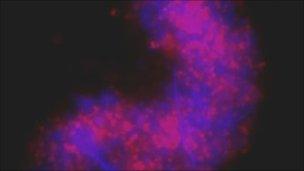Glowing wound dressing indicates infection
- Published

The polymers activate a pink fluorescent dye when they come into contact with bacteria
A wound dressing that glows to indicate an infection has been developed.
Scientists at Sheffield University have produced a gel containing molecules that bind to bacteria and activate a fluorescent dye.
The dressing emits a pinkish glow under ultraviolet light when harmful levels of bacteria are present.
It should help doctors treating chronic wounds such as ulcers. Army medics could also use it to identify soldiers with infected battlefield injuries.
Part of the funding for the research has come from the Defence Science and Technology Laboratory, an agency of the Ministry of Defence.
It is hoped that testing on patients will begin within two years.
Bugs eradicated
Professor Sheila MacNeil, one of the researchers at the University of Sheffield, said: "If you know you've got infection it's going to change how you treat your soldiers, it's going to change how you're going to treat those patients in the home.
"We could get to an early-stage clinical trial in two to three years."
As well as shining a spotlight on bacteria, the gel can rid a wound of up to 80% of surface bugs in about three hours.
Currently, it takes several days to determine significant levels of bacterial infection by growing swab samples in the laboratory.
Bacteria highlighted by the dressing include those which cause legionella, salmonella, E. coli, MRSA, C difficile, meningitis and peritonitis.
Project leader Dr Steve Rimmer, also from the University of Sheffield, said: "The availability of these gels would help clinicians and wound care nurses to make rapid, informed decisions about wound management, and help reduce the overuse of antibiotics."
- Published8 July 2010